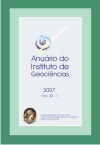Organic facies of the La Luna Formation, Upper Valley Magdalena Basin, Colômbia: implication to oil generation and characterization paleoenvironment
DOI:
https://doi.org/10.11137/2007_2_65-81Abstract
Upper Cretaceous pelitic rocks generate most of the oil reserves in Colombia. In Del Magdalena Upper Valley (MUV), the existence of good quality outcrops and thermal evolution levels that vary from immaturity to the end of the oil generation "window" makes it one of the most appropriate regions for the study of primary migration and generation of oil in Upper Cretaceous. The main objectives of this work were to study the organic facies of La Luna Formation in an outcrop section called Riacho Bambuca (Bambuca Creek), determine the oil generation potential and characterize the paleoenvironment. For this research, 24 samples were used in palynofacies analysis (characterization of the kerogen components assembly) and in organic geochemistry analysis (Total Organic Carbon - TOC analysis and Rock-Eval pyrolysis, provided by Colombia Oil Institute - ECOPETROL). The palynofacies analysis included the use of microscopy techniques (transmitted white light and incident blue light). Furthermore, a Spore Coloration Index (SCI) analysis was made in order to determine the thermal maturation stage. The studied material was composed mainly of an amorphous organic substance, with its fluorescent coloration varying from yellow to bright orange. The palynomorph group is represented by spore morph and dinoflagellate cysts. The ligneous material are present in very low percentages; they are mainly opaque phytoclasts. The results of geochemical analysis showed TOC contents ranging from medium to high, excellent potential for the generation of hydrocarbons (PG >; 4 mg HC/g of rock), hydrogen index ranging from 329 to 589 mg HC/g, and low values of oxygen index, characterizing type II kerogen. The low degree of thermal maturation was determined by Spore Coloration Index values ranging from 2,5 to 3,0, Tmax values below 440ºC and Hydrocarbon Production Index inferior to 0,2. According to the organic facies data, La Luna Formation deposited in a marine environment with facies from disoxic-anoxic distal shelf and suboxic-oxic distal basin; there was kerogen of excellent quality, and its quantity was adequate for the generation of oil.Downloads
Download data is not yet available.
Downloads
Published
2007-12-01
How to Cite
Iemini, J. A. (2007) “Organic facies of the La Luna Formation, Upper Valley Magdalena Basin, Colômbia: implication to oil generation and characterization paleoenvironment”, Anuário do Instituto de Geociências. Rio de Janeiro, BR, 30(2), pp. 65–81. doi: 10.11137/2007_2_65-81.
Issue
Section
não definida
License
This journal is licensed under a Creative Commons — Attribution 4.0 International — CC BY 4.0, which permits use, distribution and reproduction in any medium, provided the original work is properly cited.















